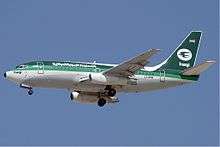Iraqi Airways Flight 163
 An Iraqi Airways Boeing 737-200 similar to the aircraft involved. | |
| Hijacking summary | |
|---|---|
| Date | 25 December 1986 |
| Summary | Hijacking, explosion in cockpit leading to crash |
| Site | Arar, Saudi Arabia |
| Passengers | 91 |
| Crew | 15 |
| Fatalities | 63 |
| Injuries (non-fatal) | unknown |
| Survivors | 43 |
| Aircraft type | Boeing 737-270C |
| Operator | Iraqi Airways |
| Registration | YI-AGJ |
| Flight origin |
Saddam International Airport Baghdad, Iraq |
| Destination |
Queen Alia International Airport Amman, Jordan |
Iraqi Airways Flight 163 was a Boeing 737-270C, registered YI-AGJ, that was hijacked in 1986. On 25 December 1986, en route from Baghdad's Saddam International Airport to Amman, Jordan, Flight 163 was hijacked by four men. Iraqi Airways security personnel tried to stop the hijackers, but a hand grenade was detonated in the passenger cabin, forcing the crew to initiate an emergency descent. Another hand grenade exploded in the cockpit, causing the aircraft to crash near Arar, Saudi Arabia where it broke in two and caught fire.
There were 106 people on board, and 60 passengers and 3 crew members died. The surviving passengers were able to tell authorities what transpired on the aircraft. The hijacking was one of the deadliest ever, and was one of many in 1985 and 1986.
Shortly after the hijacking, the pro-Iranian group "Islamic Jihad" (a widely used name for Hezbollah) claimed responsibility. One of the dead hijackers was later identified by the Central Intelligence Agency as a Lebanese national named Ribal Khalil Jallul, whose passport photo was matched to a Hezbollah martyr poster found near a mosque in Beirut.[1] Iraq accused Iran of being behind the attack.
See also
- Aviation safety
- List of accidents and incidents involving commercial aircraft
- List of aircraft hijackings
References
- ↑ Robert Baer, See No Evil, Three Rivers Press, 2002. p 113
